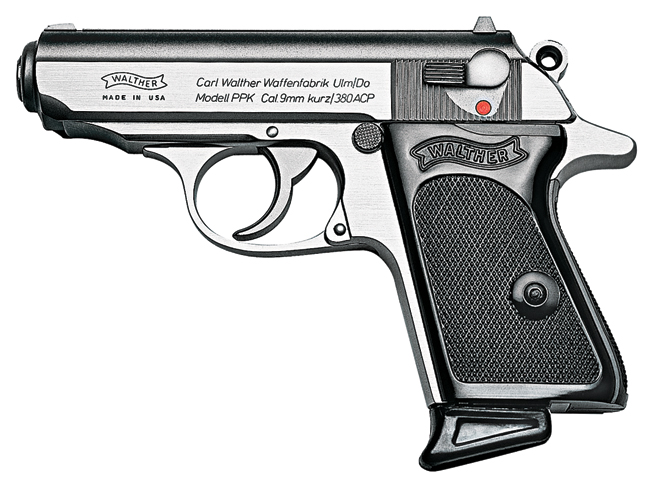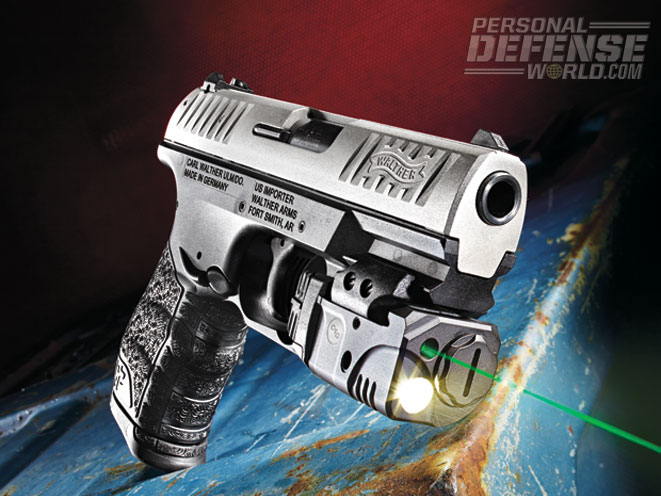Walther has a storied history building small semi-autos that dates back to the early 20th century. The legendary German armsmaker introduced the groundbreaking double-action .380 PPK in 1930 and has been manufacturing that model, along with the later PPK/S, for more than 80 years. Success has never kept Walther from making continual improvements and embracing new technology, which brings us to the latest 9mm model to bear the Walther name: the CCP (Concealed Carry Pistol).
The CCP, available in two-tone or Cerakote black, is an innovative design that offers compact dimensions for ease of carry and, like the popular Walther PK380 and striker-fired subcompact 9mm Walther PPS, the CCP also utilizes a polymer frame. However, unlike any previous Walther model, the CCP combines blowback operation (used on models like the PPK) with innovative gas-piston technology.
Next-Gen Nine
Advertisement — Continue Reading Below

Field stripping the CCP reveals an amalgamation of old and new technology, with a PPK-style fixed barrel and a single, large recoil spring. Aside from that, however, the operation of the gun is unlike any other Walther. The CCP utilizes a “Soft Coil” gas-delayed blowback action. When fired, a portion of the gas pressure from the ignited cartridge is directed downward through a small port in the bottom of the barrel and into a chamber located inside the frame. Think of it as a secondary recoil system that is otherwise passive if the gun is not being fired. This allows the primary recoil spring to be lighter, reducing slide resistance when chambering a round or clearing the gun. In operation, the gas piston, which is attached to the underside of the slide, fits into that chamber in the frame and uses the gasses from the discharged round to create back pressure. As the blowback action drives the slide rearward, the piston pushes against the trapped gasses, slowing the slide’s recoil until the bullet exits the barrel and releases the remaining internal pressure, after which the slide is allowed to end its rearward motion, opening the breech and ejecting the empty cartridge case. The reduced recoil effect decreases muzzle lift, increasing control of the pistol.
RELATED: Gun Review – Walther PPQ M2 9mm
The striker-fired, 9mm CCP has a 4.5-pound trigger pull, an interchangeable front sight with a white dot, an adjustable white-dot rear sight, and a reversible magazine release for left- or right-handed operation. The CCP also has a very slim manual thumb safety that proved easy to operate on the draw, and an internal firing pin block (drop safety). Trigger pull (on the test gun) averaged 4.5 pounds with 0.5 inches of take-up.
Advertisement — Continue Reading Below
While larger than many subcompacts, it has very concealable dimensions: an overall length of 6.41 inches with a 3.54-inch barrel, width of 1.18 inches and a leggy 5.12-inch height, which allows an eight-round magazine, giving the CCP an impressive 8+1 capacity and a carry weight of only 22.33 ounces unloaded.
RELATED: Gun Review – Wunderbar Walther PPX .40
Advertisement — Continue Reading Below
For the range test I fired traditional 115-grain full metal jacket (FMJ) rounds from Winchester, Speer Gold Dot Personal Protection 115-grain hollow points (HP), and Federal Premium Personal Defense 124-grain Hydra-Shok jacketed hollow points (JHP). Best groups measured 2 inches with Winchester FMJ, 2.25 inches for Speer and 2.3 inches with Federal JHP.
.380 Firepower

In 1929 Fritz Walther revolutionized the small-caliber semi-auto market with the introduction of the world’s first double-action (DA) pistol, the Model PP chambered in either .32 ACP or .380. Two years later, Walther added the compact PPK version, which became one of the most popular pistols in the world.
Advertisement — Continue Reading Below
RELATED: Walther PPK/S .22 – James Bond’s Sidearm Gets An Upgrade
Weighing only 22.4 and 24 ounces, current PPK and PPK/S .380 models have 3.3-inch barrels and a capacity of 6+1 and 7+1, respectively. Overall length is 6.1 inches, width is 1 inch, and height 3.8 and 4.3 inches, respectively. Featuring a fixed barrel and low bore center, both models use traditional blowback actions.
Modernized Design
Advertisement — Continue Reading Below

As a concealed carry sidearm, the PPS ventured into territory previously occupied by smaller caliber semi-autos. Introduced in 2008, the PPS, with its 3.2-inch barrel, can almost hide behind a PPK/S, yet it fires the more powerful 9mm round. The standard magazine holds seven rounds, and there is a more compact six-round version that fits flush to the bottom of the grips. An optional eight-round magazine is also available. The PPS measures just 0.9 inches in width. Overall length is 6.3 inches and height a compact 4.4 inches with the six-round magazine. The Walther PPS employs a variety of technologies including a polymer frame, an ambidextrous magazine release built into the triggerguard and interchangeable backstraps. The striker-fired design uses a blade trigger safety with an average trigger pull of 6.1 pounds.
Clearly, there is a Walther option out there for just about every CCW enthusiast. Take a look to see what might work best for you.
For more information, visit http://www.waltherarms.com or call 479-242-8500.
Advertisement — Continue Reading Below





































